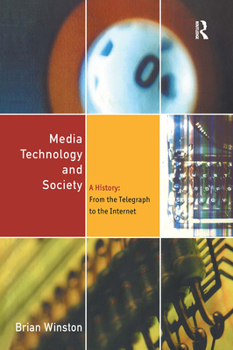Media Technology and Society: A History From the Printing Press to the Superhighway
Select Format
Select Condition 
Book Overview
Challenging the popular myth of a present-day 'information revolution', Media Technology and Society is essential reading for anyone interested in the social impact of technological change. Winston argues that the development of new media forms, from the telegraph and the telephone to computers, satellite and virtual reality, is the product of a constant play-off between social necessity and suppression: the unwritten law by which new technologies...
Format:Paperback
Language:English
ISBN:041514230X
ISBN13:9780415142304
Release Date:April 1998
Publisher:Routledge
Length:392 Pages
Weight:1.35 lbs.
Dimensions:0.8" x 6.2" x 9.2"
Customer Reviews
3 ratings
Read the Back Cover, Folks
Published by Thriftbooks.com User , 17 years ago
I loved this book. I first read it shortly after it was published, and since then it has stuck with me as the definitive and useful explanation for how and why media technologies are embraced by the general public. I'm writing largely because I find the two negative reviews annoying. Giving a book a bad rating solely because it didn't contain what you thought that it should contain is not useful to anyone. This book is a social history of media technology, something that it very clearly spells out both in its title and in the blurb on the back cover. And of course it's an academic book! It was written by an academic, published by an academic press, and intended for an audience familiar with the linguistic theories of Noam Chomsky (who's more than just a cranky critic of US foreign policy).
A Fantastic and Informative History of Technology
Published by Thriftbooks.com User , 17 years ago
Very highly recommended for anyone with keen interest in the history of technology, society, and business. I love this book. Let me list a few of its many virtues: First and foremost, it is a learned and fascinating account of the history of many key technologies of the past two hundred years. It is rich with detail about the technologies, their invention process, the people involved and both the scientific and societal contexts into which they emerged. Second, it burts the popular myth of the singular invention arising out of the mind of one genius -- and replaces it with the story of how most of these technologies were in some way inevitable once the scientific ground had been prepared -- and how in many cases, there were many fathers of the "inventions." It also sheds very interesting light on the roles of both societal and commercial inhibiting and accellerating forces on the development and profusion of technologies. For someone who makes his or her living in the business of new technologies, this is an unforgettable if slightly challenging read. It will change the way you view invention and technology and how they enter and move through our societies.
EXCELLENT PIECE OF RESEARCH & ANALYSIS
Published by Thriftbooks.com User , 24 years ago
This book won the 1998 Best Book Award by the American Association for History and Computing. It not only provides a comprehensive account of the history of electronic communications from telegraphy to the Internet, but also offers a model with which to understand the processes of change in the technologies of communication.The purpose of book is not only to explicate a fuller account of what actually occurred in the telecommunications past but also to offer an interpretation, necessarily synthetic and revisionist, of those occurrences. The model offers an understanding of the history and the current position of communications in our culture. This understanding is not solely dependent on the performance of technology, but is also heavily dependent on an examination of the operation of the social necessities and constraints.Brian Winston's fascinating account challenges the popular myth of a present-day `information revolution' in communications technology by highlighting the long histories of such developments. The fax was introduced in 1884. Digitalization was demonstrated in 1938. Even the concept of the `web' dates back to 1945.In Part I, the author applies the model to the electrical systems of communication, the telegraph and the telephone. Then, in Part II, radio and television are dealt with. Part III is concerned with computing while Part IV looks at the whole development of electrical and electronic networks from the telegraph to the Internet. The conclusion suggestions, via a consideration of the current state of research into holography, that the model is still valid.This book is essential reading for anyone interested in the social impact of technological change.Brian Winston is Head of the School of Communication, Design and Media at the University of Westminster, the world's leading school of media and communication studies. He was previously Dean of the College of Communications at the Pennsylvania State University, Chair of Cinema Studies at New York University and Founding Director of the Glasgow University Media Group. As a television professional in the UK, he has won an Emmy for documentary script-writing.Reviewed by Azlan Adnan. Formerly Business Development Manager with KPMG, Azlan is currently Managing Partner of Azlan & Koh Knowledge and Professional Management Group, an education and management consulting practice based in Kota Kinabalu. He holds a Master's degree in International Business and Management from the University of Westminster in London.




